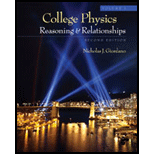
Concept explainers
(a)
The acceleration due to gravity at the surface of the Vesta.
(a)
Answer to Problem 70P
The acceleration due to gravity at the surface of the Vesta is
Explanation of Solution
Write the expression from the
Here,
Substitute
Conclusion:
Substitute
Therefore, the acceleration due to gravity at the surface of the Vesta is
(b)
The mass of the Vesta.
(b)
Answer to Problem 70P
The mass of the Vesta is
Explanation of Solution
Write the expression for acceleration due to gravity.
Here,
Rewrite the above expression for mass.
Conclusion:
Substitute
Therefore, the mass of the Vesta is
(c)
The height of the astronaut could jump on Vesta planet.
(c)
Answer to Problem 70P
The height of the astronaut could jump on Vesta planet is
Explanation of Solution
Write the expression from the equation of motion.
Here,
Rewrite the above expression for initial speed by substituting
Here,
Similarly the initial speed of the object on Vesta surface,
Here,
Conclusion:
Compare the equations (V) and (VI).
Substitute
Therefore, the height of the astronaut could jump on Vesta planet is
Want to see more full solutions like this?
Chapter 5 Solutions
College Physics, Volume 1
- The “mean” orbital radius listed for astronomical objects orbiting the Sun is typically not an integrated average but is calculated such that it gives the correct period when applied to the equation for circular orbits. Given that, what is the mean orbital radius in terms of aphelion and perihelion?arrow_forwardThe gravitational force exerted on an astronaut on the Earths surface is 650 N directed downward. When she is in the space station in orbit around the Earth, is the gravitational force on her (a) larger, (b) exactly the same, (c) smaller, (d) nearly but not exactly zero, or (e) exactly zero?arrow_forwardWhat is the approximate magnitude of the gravitational force exerted by the Sun on the Voyager 1 spacecraft when they are separated by 17.0 billion kilometers? The spacecraft has a mass of 731 kg.arrow_forward
- For a body at a height of 200m, what is the body's velocity when it reaches the earth's surface and the mass of the body is 25kgarrow_forwardThe Mars Pathfinder spacecraft used large airbags to cushion its impact with the planet’s surface when landing. Assuming the spacecraft had an impact velocity of 18.5 m/s at an angle of 45° with respect to the horizontal, the coefficient of restitution is 0.85 and neglecting friction, determine (a) the height of the first bounce, (b) the length of the first bounce. (Acceleration of gravity on Mars = 3.73 m/s2.)arrow_forwardA spaceship is midway between the earth and the moon when its engines fail. What is its acceleration? Assume that the distance from the center of the earth to the center of the moon is 3.8 x 108 m and the mass of the moon is 7.38 x 1022 kg. arrow_forward
- The acceleration due to gravity at the surface of planet A is half that on the surface of the Earth. The mass of planet A is twice the mass of the Earth. In terms of the radius of the Earth, R, the radius of planet A is: Group of answer choices A. R B. (1/√2 ) R C. 2 R D. (1/2) R E. √2 Rarrow_forwardThe acceleration due to gravity on the Moon's surface is known to be about one-sixth the acceleration due to gravity on the Earth. Given that the radius of the Moon is roughly one-quarter that of the Earth, find the mass of the Moon in terms of the mass of the Earth.arrow_forwardConsider a hypothetical planet whose mass and radius are both half that of Earth. If g is the acceleration due to gravity on the surface of Earth, the acceleration due to gravity on the planet will be A) g/4 B) g C) 2g D) g/2arrow_forward
- A man has a mass of 75 kg on the Earths surface. How far above the earths surface does he have to go to "lose" 10 % of his body weight?arrow_forwardConcern the planet Mars, which has a radius of 3400 km. On Mars, the acceleration due to gravity is 3.72 m/s^2 The mass of the sun is 2.0×1030 kg, while the (actual) mass of Mars is 6.4×1023 kg. The average distance from Mars to the sun is 228 million kilometers. a. What is the gravitational force acting on Mars due to the sun? What is the reaction force to this force? Name or explain the force; don’t give a value. b. What are the speed and angular velocity of Mars? Compare the values to those of Earth. c. Using only information provided above, estimate the length of a year on Mars. Compare the value to that of Earth.arrow_forwardCompute for the value of the acceleration due to gravity g of an object at an altitude equal to twice the radius of the earth?(6.4*106m)arrow_forward
 University Physics Volume 1PhysicsISBN:9781938168277Author:William Moebs, Samuel J. Ling, Jeff SannyPublisher:OpenStax - Rice University
University Physics Volume 1PhysicsISBN:9781938168277Author:William Moebs, Samuel J. Ling, Jeff SannyPublisher:OpenStax - Rice University Principles of Physics: A Calculus-Based TextPhysicsISBN:9781133104261Author:Raymond A. Serway, John W. JewettPublisher:Cengage Learning
Principles of Physics: A Calculus-Based TextPhysicsISBN:9781133104261Author:Raymond A. Serway, John W. JewettPublisher:Cengage Learning

